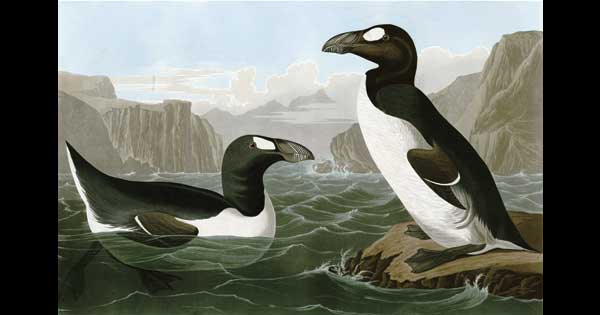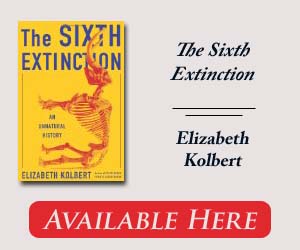
The Sixth Extinction: An Unnatural History, By Elizabeth Kolbert, Henry Holt, 302 pp., $28
Science journalism is an important enterprise with a difficult dual challenge: to translate complex research into engaging language accessible to nonspecialist readers, and to convey its subject with accuracy and insight.
In The Sixth Extinction, Elizabeth Kolbert easily meets the translation half of the challenge. Using a series of well-chosen examples that draw upon her visits with scientists across the world, she reports on ways that humans are triggering a sixth mass extinction in the history of life on Earth. Her adventurous excursions make for an engaging travelogue. But the scientific substance of The Sixth Extinction leaves much to be desired. In science as elsewhere, the devil is in the details, and Kolbert’s details ultimately compromise the potency of her book’s important message.
Problems crop up on several fronts. First, she sprinkles sketchy or inaccurate descriptions of experimental methods, concepts, and organisms throughout the narrative. Second, with the exception of one particularly deft metaphor (Kolbert compares sequencing fossil DNA to reassembling a Manhattan phone book from shredded pages “left to rot in a landfill”), many other metaphors deployed in this book are uninformative, even puzzling, in ways that expose its author’s limited scientific understanding. Certainly, popular books are not expected to adhere to the rigorous citation standards of academic monographs. Nevertheless, The Sixth Extinction is weakened by its careless approach, including frequent use of quotations without attribution and a habitual failure to acknowledge researchers by name—deficiencies even by the standards of conventional journalism.
An example of the detail problem shows up in the first chapter, which outlines the role played by the rampant spread of a chytrid fungus called Batrachochytrium in the catastrophic global decline of amphibians over the past quarter-century. Since the causes of this decline were at first completely unknown, the painstaking detective work that isolated and characterized Batrachochytrium and demonstrated its pathogenicity in frogs deserves a substantial description. But Kolbert’s account trivializes this crucial initial work and neglects to credit the investigators by name. (For the record, the “veterinary pathologist” in question is Allan Pessier, and the “mycologist at the University of Maine” is Joyce Longcore.)
 The next section depicts past extinctions, with the goal of “placing [the sixth extinction] in the broader context of life’s history.” One chapter, a nightmarish account of the human-caused extinction of the great auk, is the most compelling part of the book. But her discussions of the five previous mass extinctions are diminished by inaccuracies and superficial analysis. A 1977 discovery by the father-son team of Luis and Walter Alvarez, of an iridium “spike” at the post-Cretaceous boundary in fossil rocks, which in turn generated a 1980 hypothesis (now confirmed) that an asteroid impact caused the Cretaceous extinction, was revolutionary. But Kolbert fails to mention that it occurred amid a much larger revolution in paleontology. Her portrayal of old-fogey paleontologists scornfully dismissing the asteroid theory is not the full story. Throughout the 1970s, a group of young paleontologists, including Stephen Jay Gould, Niles Eldredge, David Raup, and others, was steadily amassing data documenting the taxonomic breadth and provocative temporal patterns of mass extinctions; these paleontologists embraced the implications of the Alvarez discovery with enthusiasm. Several of them (including Gould, who composed some of his finest essays on this topic) have written excellent popular articles and books on mass extinction. I recommend these works for a richer, more astute level of commentary than Kolbert provides.
The next section depicts past extinctions, with the goal of “placing [the sixth extinction] in the broader context of life’s history.” One chapter, a nightmarish account of the human-caused extinction of the great auk, is the most compelling part of the book. But her discussions of the five previous mass extinctions are diminished by inaccuracies and superficial analysis. A 1977 discovery by the father-son team of Luis and Walter Alvarez, of an iridium “spike” at the post-Cretaceous boundary in fossil rocks, which in turn generated a 1980 hypothesis (now confirmed) that an asteroid impact caused the Cretaceous extinction, was revolutionary. But Kolbert fails to mention that it occurred amid a much larger revolution in paleontology. Her portrayal of old-fogey paleontologists scornfully dismissing the asteroid theory is not the full story. Throughout the 1970s, a group of young paleontologists, including Stephen Jay Gould, Niles Eldredge, David Raup, and others, was steadily amassing data documenting the taxonomic breadth and provocative temporal patterns of mass extinctions; these paleontologists embraced the implications of the Alvarez discovery with enthusiasm. Several of them (including Gould, who composed some of his finest essays on this topic) have written excellent popular articles and books on mass extinction. I recommend these works for a richer, more astute level of commentary than Kolbert provides.
The final section of her book returns to current environmental problems. Chapters on habitat destruction and invasive species nicely explain how land development causes the reduction and fragmentation of habitats and how the human transport of nonnative species merges ecological communities in potentially disastrous ways.
Two chapters describing environmental problems in the ocean illustrate why scientific understanding is a crucial requirement for science writers. Kolbert appears to know very little about oceanography or marine organisms. Her confused explanations of the interaction of CO2 , pH, calcification, and ocean acidification—a central focus of these chapters—are so inadequate that they would not merit a passing grade in a freshman marine biology course. Her portraits of marine organisms similarly miss the mark. Take this misbegotten simile: “Like the Jews, the corals of the Great Barrier Reef observe a lunar calendar.” These chapters are an embarrassment.
Despite its limitations, The Sixth Extinction calls much-needed attention to the ways in which the very factors responsible for the evolutionary success of Homo sapiens now endanger the future of many of Earth’s species, including Homo sapiens. Read Kolbert on the extinction of the great auk, as horrifying testimony to the ecological devastation that can be wrought by human ignorance and greed. But look elsewhere to gain an understanding of the evolutionary biology of mass extinction and to learn about the scientific basis of the environmental crisis in the oceans, and our interdependence with the important marine organisms imperiled by it. Only then will you appreciate what we stand to lose if we do not find the will to undo the damage we have caused.

